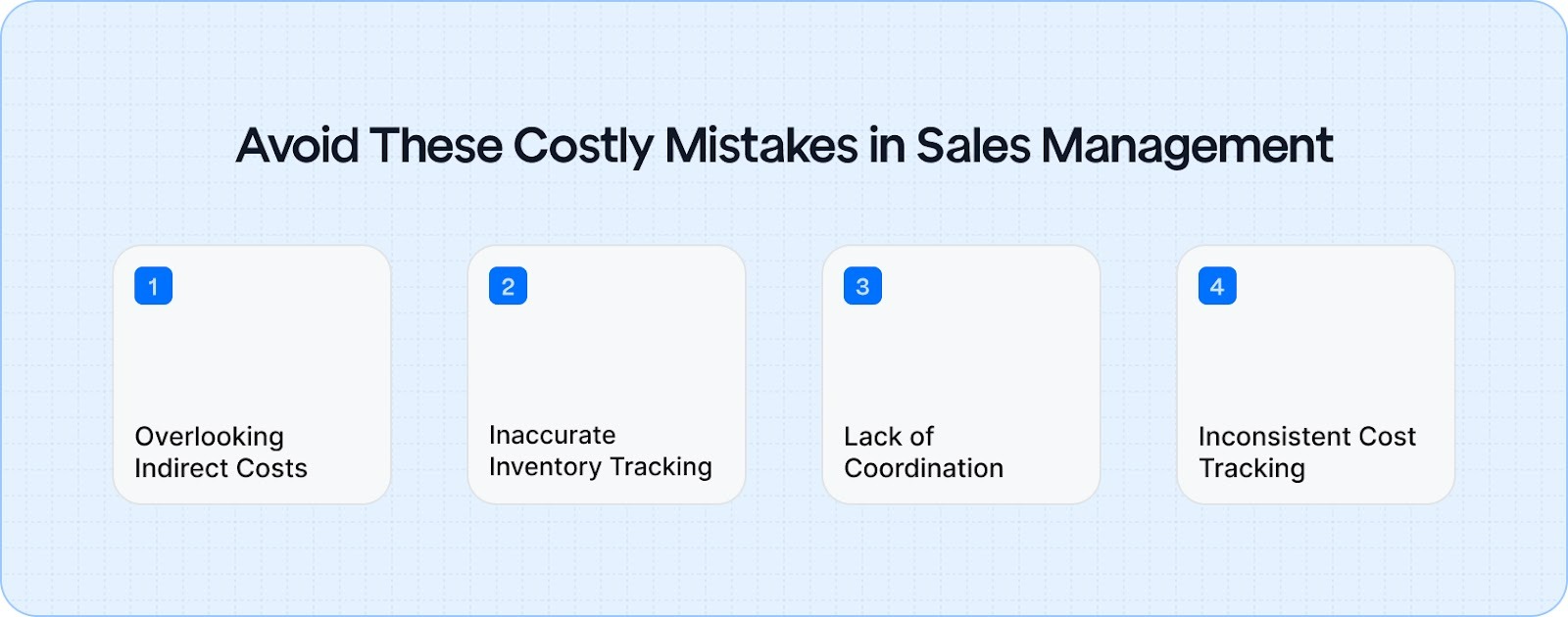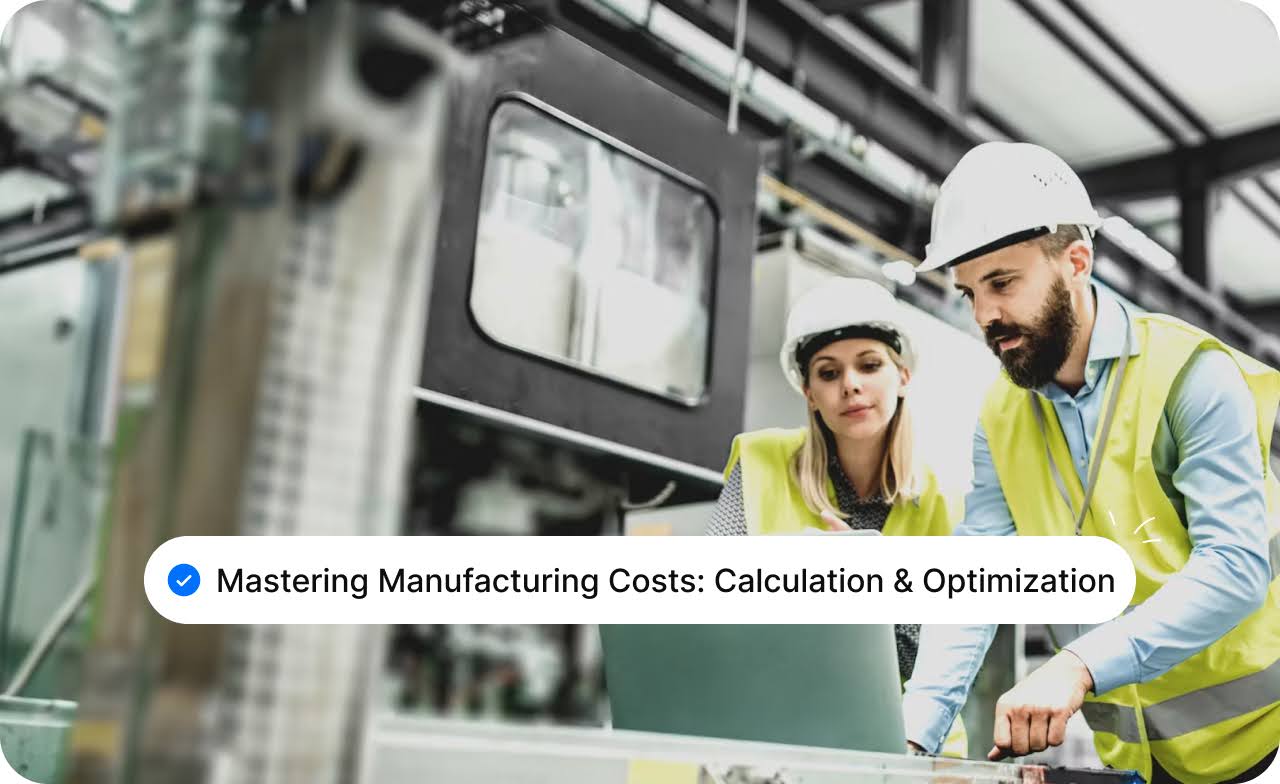Manufacturers face constant pressure to stay competitive, and a structured, customer-centric sales approach is key.
Understanding the true cost of sales is crucial for improving profitability. Tracking direct expenses like materials, labor, and overhead is simple. Although, hidden costs like material price volatility, supply chain disruptions, and production inefficiencies often go unnoticed. These costs can quietly erode margins, leaving little room for growth.

This guide breaks down the process of calculating your cost of sales and offers practical strategies to optimize it, helping you reduce waste, streamline operations, and boost profitability.
What’s the Real Cost of Your Sales? Let's Break It Down
Cost of sales, also known as cost of goods sold (COGS), includes all direct costs associated with producing the goods that a company sells. This includes:
- Raw Materials: The cost of the basic materials used in manufacturing products.
- Labor: The wages of workers directly involved in the production process.
- Manufacturing Overhead: Indirect costs that are essential for production, such as factory utilities, machinery maintenance, and insurance.
COGS captures production costs. Operating expenses (OPEX) are the costs to run the business that aren’t tied to making units, e.g., marketing, administrative salaries, office rent, and head-office utilities.
Many manufacturers assume COGS is just about materials and labor, but there's a deeper layer that can impact your profitability significantly. Let’s break it down.
COGS vs. Operating Expenses:
It’s crucial to understand the difference between COGS and Operating Expenses (OPEX).
- COGS refers to the direct costs associated with the production of goods, including raw materials, labor, and overhead costs.
- Operating Expenses (OPEX), on the other hand, are the expenses not directly tied to production, like marketing, salaries of sales staff, rent, and office supplies.
Why does this matter?

The distinction is key in financial reporting. By accurately categorizing your costs, you can:
- Improve profitability analysis.
- Gain clearer insights into cost drivers.
- Make better pricing and financial decisions.
How to Crunch the Numbers: COGS Calculation Made Simple
The basic formula for calculating COGS is simple but requires accuracy at each step:

Detailed Breakdown:
- Direct Materials: Define direct materials as the raw materials that become part of the finished product. Calculate material costs based on inventory records and purchase receipts.
- Direct Labor: Direct labor costs are wages paid to workers who are directly involved in the production process. This includes both full-time employees and temporary labor used in production.
- Manufacturing Overhead: These are indirect costs that support the production process. This includes factory rent, utilities, equipment depreciation, and factory supplies.
These costs can be harder to track, but are just as important for accurate cost calculation.
Example Calculation: Let's say your company's inventory details are as follows:
- Beginning inventory: $50,000
- Purchases during the period: $120,000
- Ending inventory: $40,000
So, the COGS would be: COGS = $50,000 + $120,000 - $40,000 = $130,000
This means your direct production costs for the period total $130,000.
What’s Killing Your Costs? The Factors You Can't Ignore
Manufacturers face constant pressure from rising costs that erode their margins. Fluctuating material prices, inefficient labor, and overhead costs can quickly drive up your expenses, making it crucial to take control of these factors.
- Material Costs: Fluctuating raw material prices can drive up your COGS quickly. Volatility in commodity markets and supplier price hikes can throw off your cost projections.
- Mitigation Strategies: Lock in prices with long-term supplier contracts and bulk purchasing to reduce material cost fluctuations.

- Labor Costs: Labor efficiency directly impacts COGS. Inefficient workflows and overtime can escalate labor costs.
- Optimization Strategies: Automate routine tasks and invest in cross-training employees to maximize productivity while reducing reliance on overtime.
- Overhead Costs: Indirect costs like factory rent and utility bills can silently eat into your margins.
- Supply Chain Factors: Global supply chain issues, like tariffs and shipping delays, can increase production costs.
Inventory Valuation Methods: FIFO, LIFO, and the Rest, Which One's Right for You?
FIFO (First In, First Out): FIFO assumes that the oldest inventory items are sold first. This method works well during periods of inflation as older, cheaper inventory is sold first, keeping COGS lower.
FIFO results in a higher ending inventory value and can boost profit margins in times of rising material costs.
LIFO (Last In, First Out): LIFO assumes that the most recent inventory is sold first. This method is advantageous during inflationary periods as it matches higher current costs to sales revenue, resulting in a higher COGS and lower taxable income.
Average Cost Method: The average cost method smooths out the fluctuations in material prices by averaging the cost of all units, regardless of when they were purchased.
This method helps maintain consistent COGS over time, especially in industries with high inventory turnover or volatile material costs.
Choosing the Right Method: The right inventory valuation method depends on your:
- Production Type: High-turnover, low-cost items may benefit from FIFO or Average Cost, while high-value, low-volume items might favor LIFO.
- Financial Strategy: FIFO generally results in higher profits (during inflation), which could be useful for showing strong performance, while LIFO could benefit companies looking to reduce tax liabilities in times of price hikes.
More COGS = Less Profit: How This Affects Your Bottom Line
Understanding how COGS affects your bottom line is crucial for staying competitive. A high COGS can eat into profits, making it essential to optimize production and pricing strategies.
Gross Profit and Margin
COGS directly impacts your gross profit, which is calculated by subtracting COGS from revenue. If COGS is high, your gross profit margin will shrink. A lower margin means you will need to either increase sales or reduce costs to maintain profitability.
Impact on Pricing Strategy
Knowing your COGS helps set the right price for your products. If your COGS is too high, increasing your prices might be necessary. However, the price hike must still be competitive in the market.
Failing to optimize COGS might force you to raise prices, risking a loss of market share to competitors.
Operational Efficiency
Optimizing COGS is about improving operational efficiency. Reducing inefficiencies in production by eliminating waste, improving labor productivity, and automating processes can lower COGS without sacrificing quality.
Small improvements can lead to significant savings over time.
Example: A company specializing in custom-made furniture noticed that rising labor costs were inflating its COGS.
After re-engineering their production process and investing in automated equipment, they reduced labor costs and improved production efficiency, increasing their gross profit margin by 15%.
Get Your Sales Costs Under Control: 6 Ways to Optimize COGS
Managing your COGS is the key to unlocking higher profits. Even a small increase in production costs can eat away at your margins, making it harder to stay competitive.
1. Negotiating Better Supplier Terms
One of the easiest ways to lower material costs is through better supplier negotiations. By locking in favorable prices with long-term contracts or purchasing materials in bulk, manufacturers can control material cost fluctuations, leading to more predictable COGS.
2. Lean Manufacturing Techniques
Lean manufacturing is all about eliminating waste in production processes. By minimizing waste, reducing overproduction, and optimizing labor, you can significantly lower COGS. The less waste you generate, the fewer materials and labor costs you incur.
3. Technological Advancements
Investing in automation or adopting AI-driven technologies can lower labor costs and improve production efficiency. AI systems can optimize production schedules, reduce downtime, and maintain consistency in output, leading to a reduction in COGS.
4. Process Automation
Automating tasks such as assembly, inspection, or packaging can cut down on manual labor, reduce errors, and improve speed. Over time, this leads to significant savings in labor costs and a decrease in COGS.

5. Inventory Management
Just-in-time (JIT) inventory systems can help keep inventory costs low by reducing the need for excessive stock storage, which reduces overhead costs and minimizes material waste.
6. Energy Efficiency
Reducing energy consumption in production processes is another way to lower overhead costs and improve overall COGS efficiency.
Investing in energy-efficient equipment, optimizing heating/cooling systems, and using renewable energy sources can drive down utility costs and improve your cost structure.
COGM vs. COGS: Know the Difference, Boost Your Profits
COGM, or Cost of Goods Manufactured, includes the total costs involved in producing goods, such as direct materials, labor, and manufacturing overhead.
This differs from COGS, which is the cost of the goods that were actually sold. COGM is used to assess manufacturing efficiency, while COGS shows the direct expenses related to sales.

Link to COGS: By understanding COGM, you can accurately calculate COGS. COGM provides the production cost of all goods made during the period, while COGS reflects the cost of those goods sold.
Both metrics are crucial for tracking your profitability and performance over time.
Example: A company with $50,000 in direct material purchases, $30,000 in direct labor, and $20,000 in overhead will have a COGM of $100,000. If $60,000 worth of goods were sold, the COGS for that period would be $60,000.
Track, Tweak, Repeat: The Key to Mastering Manufacturing Costs
Mastering manufacturing costs is an ongoing process of constant evaluation. By tracking costs in real-time and continuously refining your strategies, you can stay ahead of rising expenses and boost profitability.
Real-Time Tracking with ERP Systems
By using ERP (Enterprise Resource Planning) systems, manufacturers can track material costs, labor, and overhead in real-time, ensuring more accurate financial data and faster decision-making.
Real-time data enables better control over COGS and allows you to address issues as they arise.

Continuous Improvement
Manufacturers should embrace continuous improvement practices like Kaizen to constantly evaluate and improve cost management strategies.
This can involve everything from streamlining production workflows to optimizing supplier relationships.
Cost Reduction Initiatives
Consider initiatives like outsourcing non-core functions (e.g., packaging or administrative tasks), improving supply chain management, and automating certain production processes to further reduce COGS and improve profitability.

Avoid These Costly Mistakes in Sales Management

Mistakes in cost management can snowball, leading to higher COGS and thinner margins. Avoiding these pitfalls ensures a more accurate financial picture and positions your company for long-term profitability.
Overlooking Indirect Costs
Manufacturers often focus on direct costs like materials and labor, neglecting indirect costs such as overhead, administrative expenses, and equipment depreciation. These can distort profitability estimates if not properly accounted for.
Why it Matters: Ignoring indirect costs inflates margins, leading to poor decision-making and misaligned pricing strategies.
Actionable Tip: Regularly review and allocate indirect costs across production lines to ensure your cost structure is accurate.
Inaccurate Inventory Tracking
Errors in inventory counts or outdated valuation methods can seriously impact COGS, leading to:
- Overstating or understating inventory values.
- Incorrect COGS calculations, skewing profitability.
- Stockouts or overstocking resulting in lost sales or excess inventory costs.
Why it Matters: Inaccurate inventory tracking can lead to poor purchasing decisions and inefficiencies in production.
Actionable Tip: Invest in automated inventory systems and conduct regular physical counts to ensure accuracy.
Lack of Cross-Department Collaboration
When sales, production, and finance teams operate in silos, optimizing COGS becomes difficult. Misaligned priorities can lead to:
- Sales are pushing for higher prices without considering production costs.
- Production is failing to communicate material shortages.
- Finance is lacking real-time data for accurate cost forecasting.
Why it Matters: A lack of alignment can increase costs and hinder efficiency across departments.
Actionable Tip: Foster cross-department communication with shared cost-tracking dashboards and regular collaboration.
Inconsistent Cost Tracking
Inconsistent cost tracking practices across periods can lead to unreliable data, making it harder to:
- Benchmark performance
- Identify trends and cost-saving opportunities
Why it Matters: Inconsistent methods distort financial analysis and make cost management less reliable.
Actionable Tip: Standardize cost-tracking methods and use accounting software that ensures consistency.
Ready to Take Control of Your Manufacturing Costs? Let’s Make It Happen!
By now, you understand how critical managing and optimizing your cost of sales (COGS) is to improve profitability and stay competitive in the manufacturing sector. Efficient cost management is about streamlining operations, improving productivity, and enhancing your bottom line for sustainable growth.
- Accurately calculating COGS helps you understand where your costs are coming from and how to manage them better.
- Optimizing labor, material, and overhead costs is essential to boosting your profit margins without compromising quality.
- The more strategic control you have over your manufacturing costs, the more competitive and profitable your business can be.
Manufacturers often try to manage costs with quick fixes, but without a well-structured approach, the challenges continue.
FAQs
Q1: What is the cost of sales in manufacturing?
A1: The cost of sales (COGS) in manufacturing refers to the direct costs associated with producing goods sold during a specific period. This includes raw materials, labor costs, and manufacturing overhead.
Q2: How does COGS affect manufacturing profitability?
A2: COGS directly impacts profitability by reducing gross profit. The higher the COGS, the lower the profit margin, making it crucial to manage and reduce production costs to stay competitive.
Q3: What’s the difference between COGS and operating expenses in manufacturing?
A3: COGS includes direct production costs like materials, labor, and factory overhead, while operating expenses (OPEX) cover indirect costs like marketing, administration, and rent, which are not tied directly to production.
Q4: How can manufacturers track their costs effectively?
A4: Manufacturers can track costs effectively by using tools like ERP systems that provide real-time data on materials, labor, and overhead, allowing for accurate cost analysis and better decision-making.
Q5: What are the best ways to optimize the cost of sales in manufacturing?
A5: To optimize COGS, manufacturers should focus on streamlining production processes, negotiating better supplier contracts, adopting lean manufacturing techniques, and investing in automation to reduce labor and material costs.
Q6: How do inventory management methods impact COGS?
A6: Different inventory methods (FIFO, LIFO, or average cost) affect COGS calculations. FIFO tends to reduce COGS during inflationary periods, while LIFO can provide tax advantages, though it may result in higher COGS and lower profits.
Q7: What is the relationship between COGM and COGS in manufacturing?
A7: Cost of Goods Manufactured (COGM) represents the total production costs for goods completed during a period, while COGS reflects the costs of goods actually sold. Understanding both helps accurately track profitability.




















.webp)








.webp)



.svg)







.svg)